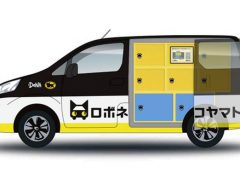- Tags:
- Disability / Orihime / Ory Laboratory / Robot / Robotics / telepresence
Related Article
-

Hand-Holding Robot MaSiRo Wants To Be Your Anime Robot Maid Come To Life
-

Robot Driven Delivery Services Expected To Launch In Japan Next Year
-

Japan Has A Robot Vendor That Is Very Happy To Give You Ice Cream
-

A Humanoid Buddy In Your Pocket: A Phone That Is Also A Walking Robot!
-

Watch an Escalator in Japan Transform into a Wheelchair Lift
-

Traditional Japanese Inn Has Self-Parking Slippers and Self-Rearranging Furniture



Despite their enormous potential to help mankind grow and develop, robots sometimes get a bad rep. Recently, they have been increasingly branded by some media as harbingers of unemployment, destined to make most of us redundant by stealing our jobs.
Photo by Toby M
Japanese robot, OriHime, is doing the opposite of this, however, and empowering humans, like those restricted by disabilities, to work and participate in society. This December, the robots staffed a cafe in Shibuya as a trial, enabling people with disabilities to work as serving staff and interact with customers. So, I headed down to WIRED Cafe to participate in this heartwarming experiment in social robotics. But firstly, just what is OriHime?
Introducing OriHime
OriHime was created to help bed-bound inpatients regain their “everyday life” and combat loneliness.
The little white robot achieves this noble goal by being a powerful tool for communication. An OriHime unit can be piloted remotely from anywhere in the world using a smartphone or tablet. The robot is fitted with a camera and microphone, acting as the ears, eyes and mouth of the controller. It also has an adorably animate body, which gives a sense of presence to interactions between those separated by distance, and empowers people with limited mobility to communicate through gestures.
Photo by Toby M
The app used to control OriHime has a series of gesture options. Push one and its charming flipper-like arms perform the action, much to the delight of whoever is communicating to OriHime. Adorable though this is, the main purpose is to make communication feel more intimate, like the person you’re talking to is actually there. For anyone lying in a hospital bed or living with restricted mobility, OriHime is a charming tool to connect with loved ones, friends or even colleagues and clients.
Introducing the Creator
Ory Yoshifuji, who developed OriHime," grew up with a disability that affected him throughout his life. Ory particularly remembers the loneliness he felt when his disability prevented him from attending school for 3 years as a youngster. This feeling inspired him to create a robot that could enable anyone who faces isolation to engage with society.
He helped launch Ory Laboratory, where he now works with his small team to design and produce OriHimes to help people physically isolated from each other to connect. OriHime is being used for a range of applications such as telework in business, or for those with ALS who cannot leave their beds but can now live and interact with their families through the robot. Most recently, OriHime has been empowering people with disabilities to achieve their dreams to work.
My visit to the WIRED Cafe
*In order to protect the identities and personal information of those mentioned in this article, fake names have been used throughout this section.
From December 9th - 15th, Ory Laboratory collaborated with WIRED Cafe in Shibuya, employing people with disabilities as waiting staff who interacted with customers using OriHime. I visited the cafe to report on this overwhelmingly human robotic experience.
Photo by Toby M
Stepping into WIRED Cafe, I was greeted by an OriHime-D, the much larger wheeled version of OriHime. “Irasshaimase,” (welcome) it said in Japanese as it rolled down the aisle holding a tray of tea and cakes. Its controller, who I later learned was in a hospital in Osaka, stopped the robot at a table to deliver the beverages and began happily chatting with the clientele. The first thing that struck me was how natural this scene seemed. It was the kind of chit chat you see in any restaurant, android appearances aside.
Photo by Toby M
A selection of tables in WIRED Cafe were fitted with standard OriHime units. When I sat down , my OriHime has its little head bowed, arms waiting patiently by its side. The tablet to its right displayed details of OriHime’s pilot, and our waiter for the day, Eguchi-san. The tablet showed his picture and a description of his disability.
After a few seconds of motionlessness, its eyes lit up a vibrant shade of green and it sprung into life. Its little head tilted to the left to face me. “Welcome, my name’s Eguchi”, he said; his energetic voice crisp and clear through the speakers.
Photo by Toby M
Eguchi-san explained the menu on the table to me and even displayed pictures of the cakes on the tablet to the left of his Orihime. I ordered tea and a soy tiramisu. WIRED Cafe has an extensive menu with items suitable for vegans and people with specific dietary requirements. Eguchi-san communicated my order to the staff via a tablet on their counter.
We chatted while I waited for my cake and drinks. Eguchi-san was based in Chiba prefecture near Tokyo. He explained that an unfortunate combination of illnesses meant he was confined to a medical centre. OriHime allowed him to interact with the world outside and find more opportunities to smile. This was touching and during our conversation, Eguchi-san sounded like he was smiling a lot.
Photo by Toby M
Eguchi-san demonstrated OriHime’s adorable range of gestures. He explained OriHime performs gestures according to buttons on his app as he cycled through them. The little robot spread its arms as if inviting a hug, clutched its head as if confused and clapped its hands to its face to show shock. At one point, a waiter mistakenly brought some coffees to my table and in response Eguchi-san used OriHime’s shocked gesture with perfect comic timing. Charming and funny, Eguchi-san’s jovial character really came through via Orihime.
My conversation with Eguchi-san was interrupted by the arrival of OriHime-D, holding a tray of cakes. The robot was being moved up and down the cafe on a magnetic strip, collecting orders from the bar and taking them to tables.
Photo by Toby M
I was impressed to see OriHime-D’s driver and Eguchi-san exchange friendly greetings across my table. Suspending my sense of disbelief, I savored the futuristic feeling that came from watching two robots chatting.
OriHime-D’s pilot explained she was working today from her hospital bed in Osaka. Having grown up in Tokyo, she reminisced about times she spent in Shibuya. Due to her Illness however, she had not been back for 5 years, so seeing the city through OriHime’s eyes felt special. I realized then that OriHime was just as much about making its user feel presence as it was about creating a sense of presence for anyone talking to OriHime. This robot has the potential to connect people, places, time and experiences.
Photo by Toby M
After OriHime-D returned to the bar, we ate our delicious cakes: soy Tiramisu, gluten-free chocolate cake, and Montblanc. All three were deliciously rich and worth visiting WIRED Cafe for next time you’re in Shibuya.
Eguchi-san said he was happy to see us enjoying the cakes. When we asked if he enjoyed this work, he was positively enthusiastic. He explained that he had only been working for 5 days, but hoped that a permanent cafe staffed by OriHimes would open one day. I told him I couldn’t agree more. I came to WIRED Cafe attracted in part by the spectacle of robots, but what I found was people. People, who, despite being separated by vast distance, were able to work, chat and share, all through OriHime. I felt OriHime’s presence functions: physical form and fluid gesturing, empowered Eguchi-san and I to connect on a much deeper level than phone or video communication ever could. OriHime breathed life into our decidedly human interaction.
The Human Robot
Photo by Toby M
After 50 minutes, our time was up and we had to leave. I exchanged goodbyes with Eguchi-san who then used OriHime to wave us out of the cafe. On my walk home, I reflected on this experiment. The experience was not for everyone. It took time to adjust to sitting at a table where a stranger was constantly present in robot form. For anyone who wanted to dine alone with their thoughts, this may be uncomfortable. For me however, this experience filled a hole I find in Japanese customer service. Tightly organized and highly efficient, Japanese customer service often keeps customer interaction limited beyond predictable scripts; it sometimes feels robotic. In WIRED Cafe however, I finally found the spontaneous chit chat with staff I craved: made possible by a robot. OriHime enabled that human connection which, for me, epitomizes great customer service.
OriHime: The Future
In the era of digital communication and remote work, faced with a shrinking labor market, it’s easy to imagine OriHime opening doors for people previously unable to participate in the workforce. In Japan especially, society is becoming increasingly accessible for people with disabilities. OriHime may not only pave a new path for empowerment in Japan but also globally, by connecting people and opportunities across the world.
If you’re interested in learning more about OriHime, check out the Ory Laboratory website, or follow them on Twitter.
On January 25th, 2020, Ory Laboratory's infrastructure engineer Fujiken will be the guest speaker at the Akaoni-chan no Tesugaku Jigoku 赤鬼ちゃんの哲学地獄 talk series hosted by Sachi Aki. This is a great opportunity for anyone to get a sneak peek into a more utopian future, where robots and humans support each other, face to face, side to side, or across remote locations. For more information, see the event page on Facebook (Japanese only).